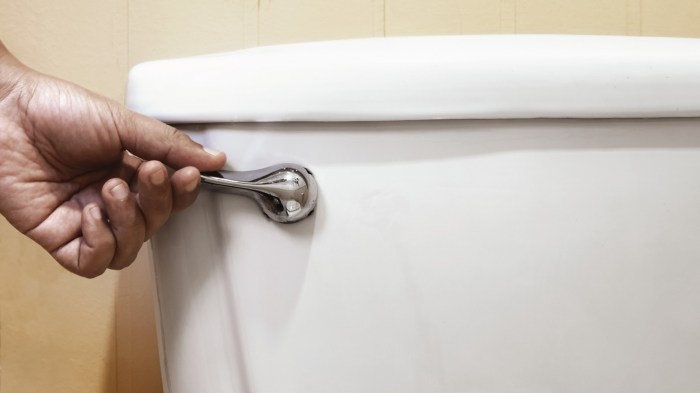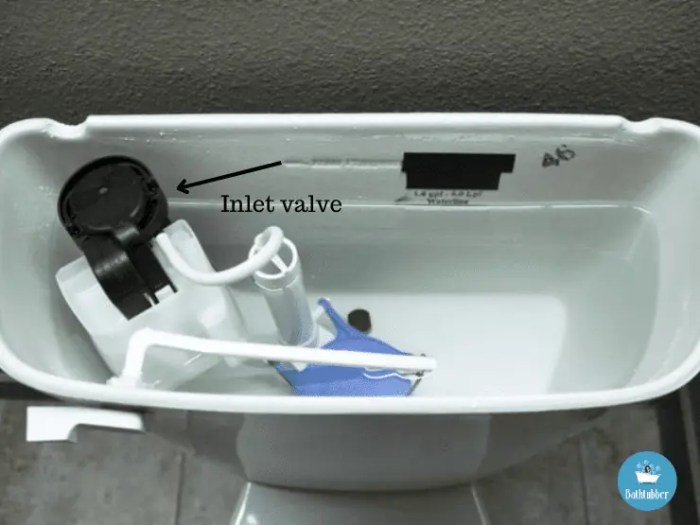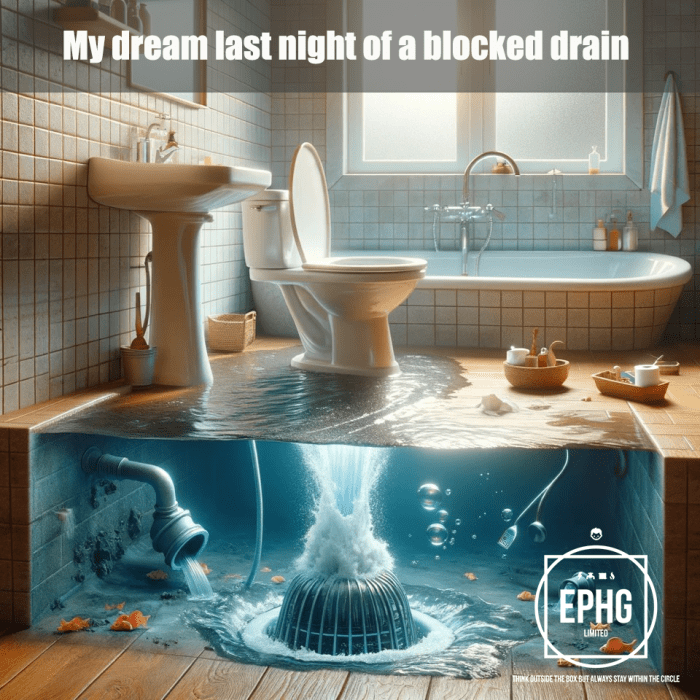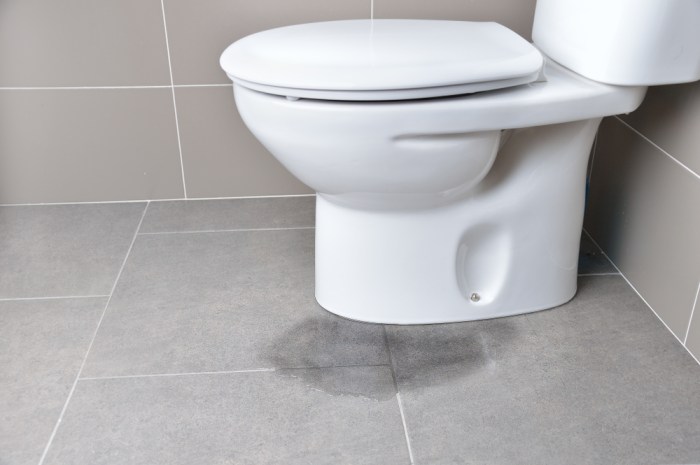Slow Flushing Toilets A House-Wide Problem
All toilets in house flushing slowly can be a frustrating and inconvenient issue. Beyond the obvious annoyance of a sluggish flush, there are underlying causes that can impact your entire household. This guide explores the possible culprits, from simple clogs to more complex plumbing problems, and provides a step-by-step approach to diagnose and resolve the issue.
From identifying the symptoms to implementing preventive measures, this comprehensive guide offers a clear and detailed plan to tackle this common household plumbing problem. We’ll delve into troubleshooting techniques, potential solutions, and preventative strategies to ensure your toilets are flushing properly and your household routines remain smooth.
Problem Description
Slow flushing toilets in a household present a common inconvenience. This issue often goes beyond mere annoyance, impacting daily routines and potentially indicating underlying plumbing problems. Understanding the causes and symptoms is crucial for effective troubleshooting and resolution.
Multiple slow-flushing toilets in a home can point to a systemic problem, rather than isolated malfunctions. This suggests a potential blockage or obstruction affecting the entire plumbing system.
Potential Causes of Slow Flushing
A variety of factors can contribute to slow flushing, including obstructions within the toilet’s plumbing system, such as clogs, debris, or mineral buildup. Insufficient water pressure from the main supply line can also result in a slow flush. In some cases, a problem with the toilet’s components, such as the flapper, chain, or flush valve, may be the culprit.
Symptoms Beyond Slow Flushing
Beyond the obvious slow flushing, homeowners may observe other symptoms. These could include a gurgling sound during flushing, water overflowing from the tank, or a noticeable delay between the flush initiation and the complete flushing cycle. Persistent or recurring issues in multiple toilets can signal a more significant problem.
Common Factors Affecting Multiple Toilets
Several factors can affect multiple toilets simultaneously. These could include a low water pressure supply, a problem with the main water supply line, or a blockage in the main drain line feeding multiple toilets. Moreover, a change in the household’s water usage habits could also affect the performance of multiple toilets.
Impact on Household Routines and Comfort
Slow flushing toilets can disrupt household routines. The increased time spent waiting for a toilet to flush can lead to frustration and inconvenience, especially during busy times. The potential for a complete blockage further increases this disruption, necessitating a plumber’s intervention and potentially impacting daily activities.
Comparison of Potential Causes for Multiple Slow-Flushing Toilets
| Potential Cause | Description | Impact on Multiple Toilets |
|---|---|---|
| Low Water Pressure | Insufficient water pressure from the main water supply. | Multiple toilets flush slowly due to inadequate water volume. |
| Main Drain Line Blockage | A blockage in the main drain line serving multiple toilets. | All toilets experience slow flushing due to reduced drain capacity. |
| Mineral Buildup | Mineral deposits accumulating in the pipes. | Multiple toilets may show reduced flushing efficiency over time. |
| Problem with Flush Valve | A faulty flush valve in the toilet mechanism. | Multiple toilets with similar valve type might exhibit slow flushing. |
| Toilet Tank Leak | A leak within the toilet tank. | Potentially causing low water levels in the tank, impacting multiple toilets’ flushing. |
Troubleshooting Steps
Slow flushing toilets can be a frustrating plumbing issue. A methodical approach to troubleshooting is key to identifying and resolving the problem efficiently. This guide provides a step-by-step procedure for investigating the cause of slow flushing, focusing on common clogs and obstructions within the toilet system.
Identifying the root cause of slow flushing often involves a systematic process of elimination. This process begins with a visual inspection and progresses to more involved checks, allowing you to pinpoint the specific issue hindering proper flushing.
Inspecting the Toilet Tank
The toilet tank is a critical component in the flushing process. An obstruction in the tank can prevent the tank from filling correctly or emptying completely. This may include a foreign object lodged within the tank or an issue with the flapper or chain mechanism. Thoroughly inspect the tank for any visible blockages or signs of damage to the flapper or chain.
- Check the tank’s water level. An abnormally high or low water level could indicate a problem with the fill valve or a leak. The water level should reach the appropriate level for the fill valve, as indicated by the manufacturer’s specifications. A consistently fluctuating water level can be an indicator of a leak.
- Examine the flapper. A worn, damaged, or improperly seated flapper can prevent a complete seal, causing slow flushing. Look for signs of wear, tears, or improper alignment. Ensure the flapper is correctly attached to the tank’s rim and sits flush against it.
- Inspect the chain. A stiff or tangled chain can impede the flapper’s ability to close properly. Ensure the chain is properly routed and free of kinks or tangles.
Assessing the Toilet Bowl
Obstructions in the toilet bowl itself can also contribute to slow flushing. Foreign objects, such as toys or other debris, can accumulate in the bowl, creating a blockage. The presence of any such obstruction should be carefully examined.
- Visually inspect the bowl for any visible blockages. Look for items such as toys, paper, or other foreign objects that might be hindering the flushing action.
- Check for any sediment buildup or debris in the bowl’s trapway. This is the path that the water takes to exit the toilet bowl. Such accumulation can restrict the water flow and lead to slow flushing.
Troubleshooting Plumbing Clogs
A clog in the plumbing system beyond the toilet itself can also lead to slow flushing. A clog in the drain line or pipe leading to the toilet can significantly impact the toilet’s flushing efficiency.
- Check the drain line or pipe leading to the toilet for any visible signs of blockage. A noticeable buildup of debris or other obstructions can be an indication of a clog.
- If you suspect a clog in the drain line or pipe, you can use a plumbing snake or a similar tool to clear the blockage. This is done carefully, following manufacturer’s instructions. This is done after other checks have been completed to ensure the problem isn’t within the toilet itself.
Comparing Approaches to Clearing Blockages
Several methods can be employed to clear blockages in the toilet or plumbing system. The most appropriate approach will depend on the nature and location of the blockage.
- Using a plunger is often the first step in dealing with a toilet clog. It creates water pressure to dislodge the blockage. A proper plunger method is essential for successful removal.
- A plumbing snake can be employed for clogs that are further down the drain line. It’s a more invasive tool but can reach deeper into the pipes, clearing obstructions that a plunger cannot reach.
Step-by-Step Troubleshooting Table
| Step | Action | Expected Result |
|---|---|---|
| 1 | Inspect the toilet tank for blockages, flapper issues, and water level | Identify any visible obstructions or malfunctions. |
| 2 | Inspect the toilet bowl for blockages or debris | Determine if foreign objects are present. |
| 3 | Check the drain line for visible blockages | Identify any obstructions in the drain line. |
| 4 | Attempt to clear blockages using a plunger or plumbing snake | Resolve the clog, restoring proper flushing. |
Possible Solutions: All Toilets In House Flushing Slowly
Slow-flushing toilets can be a frustrating plumbing issue, but many solutions are readily available. Addressing the problem effectively often involves identifying the root cause, which could be a faulty part, a blockage, or an improper water level. This section details various solutions to restore proper flushing function.
Replacing a Flapper or Chain
The flapper and chain are critical components in the toilet’s flushing mechanism. A worn-out flapper or a malfunctioning chain can lead to slow flushing. Replacing these parts is a relatively straightforward process that can often resolve the issue.
- Flapper Replacement: Carefully detach the old flapper, ensuring you have a clear understanding of its connection to the tank. Select a new flapper compatible with your toilet model. Install the new flapper, aligning it with the tank’s mounting points. Proper installation is key to preventing leaks and ensuring the flapper seals effectively. Test the flushing mechanism after installation.
- Chain Replacement: The chain connects the flapper to the flush handle. A worn or tangled chain can impede the flapper’s movement, leading to a slow flush. Disconnect the old chain, taking care not to lose any components. Install the new chain, ensuring it’s the correct length and runs smoothly without any kinks. Test the flushing action after installation.
Unclogging a Toilet
A clogged toilet can prevent the tank from emptying completely, leading to slow flushing. There are several methods to clear blockages, from simple plungers to more involved approaches.
- Using a Plunger: A plunger is a common tool for unclogging toilets. Ensure the plunger creates a tight seal around the drain opening. Firmly push and pull the plunger repeatedly to dislodge the blockage. If this doesn’t work, consider more aggressive methods.
- Using a Drain Snake: A drain snake (also known as a plumbing snake) is a flexible tool with a coiled end. Insert the snake into the drain opening and rotate it to dislodge blockages. If the blockage is stubborn, a larger or more powerful snake may be required.
Adjusting the Water Level in the Toilet Tank
An incorrect water level in the toilet tank can affect the flushing power. Adjusting the water level is often a simple fix.
- Identifying the Fill Valve: Locate the fill valve, usually positioned on the side or back of the tank. This valve controls the water level.
- Adjusting the Float: The float regulates the water level. Adjust the float to lower the water level in the tank. If the water level is too high, the water won’t be able to flush effectively. If the level is too low, it will not be able to generate sufficient force for a full flush.
Addressing Sediment Buildup in Pipes
Sediment buildup in the pipes can restrict water flow, leading to slow flushing. Regular maintenance can prevent this issue.
- Identifying the Location: Determine if the sediment buildup is in the toilet’s pipes, or if it’s in the main water lines. If it’s a larger problem, a plumber may be required.
- Prevention Strategies: Preventative measures, such as occasional flushing with a solution of vinegar and water, may help reduce sediment buildup. Avoid pouring excessive amounts of harsh chemicals down the drain.
Toilet Parts and Their Roles in Flushing
Understanding the components of a toilet and their functions helps diagnose and resolve slow flushing issues.
| Part | Role in Flushing |
|---|---|
| Flapper | Seals the tank opening, preventing water from draining out between flushes. |
| Chain | Connects the flapper to the flush handle, activating the flapper when the handle is pulled. |
| Fill Valve | Controls the water level in the tank. |
| Float | Regulates the water level by adjusting the fill valve’s opening. |
| Flush Handle | Initiates the flushing process by activating the flapper and chain. |
Preventive Measures
Slow-flushing toilets can be a frustrating plumbing issue, but proactive measures can prevent future problems. By understanding the causes and implementing preventative strategies, you can maintain a smoothly operating plumbing system. This section details how to maintain proper water pressure, perform regular checks, and adopt good waste disposal habits.
Proper preventative measures are crucial for avoiding recurring slow-flushing toilet issues. Ignoring these measures can lead to more frequent clogs and repairs, ultimately increasing your expenses. Implementing these strategies will save you time, money, and stress in the long run.
Maintaining Proper Water Pressure
Water pressure plays a critical role in toilet flushing efficiency. Insufficient pressure can result in a weak flush, leading to incomplete waste removal and potential clogs. Regularly checking the water pressure in your plumbing system is essential. A qualified plumber can accurately measure and adjust the water pressure to the optimal level for your toilets and other fixtures. This ensures that all fixtures receive sufficient pressure to function correctly.
Regular Toilet Checks and Cleaning
Regular checks and cleaning are vital for maintaining the health of your toilets and preventing clogs. A thorough visual inspection of the toilet bowl and tank can reveal potential problems early on, such as buildup of debris, mineral deposits, or loose parts. Cleaning the toilet regularly, including the tank, bowl, and trap, helps prevent clogs and keeps the system running smoothly. This routine maintenance can significantly extend the life of your toilets.
Importance of Appropriate Toilet Paper and Waste Disposal Habits
Using the correct type of toilet paper and maintaining proper waste disposal habits are key to preventing clogs. Avoid using excessive amounts of toilet paper and opt for flushable alternatives, if available. Never dispose of items that are not meant for the toilet, such as sanitary napkins, diapers, or wipes. These items can cause blockages in the pipes and lead to slow or inefficient flushing. Proper waste disposal habits are paramount to avoiding clogs.
Preventing Clogs in the First Place
Proactive measures to prevent clogs are essential for avoiding slow flushing issues. Understanding the common causes of clogs is crucial for implementing preventive measures. Regularly inspecting your toilet and plumbing system for any signs of clogs can help address potential problems before they escalate. This proactive approach minimizes the risk of costly repairs and ensures consistent toilet functionality.
Summary of Common Toilet Clog Causes and Prevention
| Cause | Prevention |
|---|---|
| Foreign objects (diapers, sanitary napkins, etc.) | Dispose of only toilet paper and appropriate waste in the toilet. |
| Excessive toilet paper | Use appropriate amounts of toilet paper. |
| Grease and food particles | Avoid flushing grease, food particles, or other non-flushable items. |
| Mineral deposits | Regular cleaning to prevent buildup. |
| Root intrusion | Professional plumbing inspection to address the root issue. |
Advanced Troubleshooting
Sometimes, standard toilet flushing problems persist even after checking the obvious. This section delves into more intricate troubleshooting techniques to identify and resolve stubborn clogs or issues beyond the immediate toilet mechanism. We’ll examine scenarios where standard solutions fail and explore the potential involvement of the broader plumbing system.
Advanced troubleshooting often involves a systematic approach, moving from simple checks to more involved inspections. Understanding the interconnected nature of the plumbing system is crucial to pinpoint the root cause of a slow flush. This proactive approach ensures a more effective and long-term solution.
Identifying Non-Standard Flushing Issues
Standard solutions like checking the flapper, chain, and water level may not address the underlying problem. This is often the case with partially obstructed drains or vents in the plumbing system. Complex clogs, especially those involving foreign objects or solidified debris, can be challenging to remove using conventional methods.
Advanced Clog Removal Techniques
In situations where standard clog removal methods fail, specialized techniques might be necessary. Using a plumbing snake, specifically designed for drain clearing, can be an effective approach for reaching and dislodging blockages further down the line. Careful maneuvering is essential to avoid damaging the pipes. For particularly stubborn clogs, a plumber might employ hydro-jetting, a process that uses high-pressure water to flush out obstructions.
Plumbing System Evaluation
Determining if the problem extends beyond the toilet is essential. A slow flush could indicate a blockage in the main drain line, vent pipe, or even a problem with the plumbing stack. Listening carefully for unusual noises in the pipes or observing slow drainage in other fixtures (sinks, showers) can help pinpoint the location of the obstruction.
Inspecting and Clearing Drains/Vents
Access to drain lines or vents might require a plumber or specialized tools. A plumber will typically use tools and techniques to inspect and clear the drains and vents. If a blockage is found, a plumber can safely and effectively clear it, preventing future slow-flush issues.
Malfunctioning Valve or Component Detection
A malfunctioning valve, such as the fill valve or flapper, can lead to slow flushing. Inspecting the components, checking for leaks, and ensuring proper operation can diagnose the problem. Signs of a malfunctioning component might include irregular water levels in the tank or inconsistent flushing pressures.
Plumbing Issue Comparison Table
| Plumbing Issue | Symptoms | Possible Causes | Solutions |
|---|---|---|---|
| Clogged Drain Line | Slow drainage in multiple fixtures, gurgling sounds | Foreign objects, grease buildup, roots | Plumbing snake, hydro-jetting, professional plumbing |
| Blocked Vent Pipe | Slow flushing, gurgling sounds, intermittent drainage | Clogs, debris, condensation | Vent inspection and clearing by a professional |
| Malfunctioning Fill Valve | Inconsistent water level in tank, weak flushing | Clogged valve, faulty mechanism | Valve replacement, repair |
| Flapper Malfunction | Leaking tank, inconsistent flushing pressure | Damaged flapper, misalignment | Flapper replacement, adjustments |
Visual Aids and Examples
Understanding the inner workings of a toilet and the potential causes of slow flushing is crucial for effective troubleshooting. Visual representations and examples can significantly aid in identifying the problem area and implementing appropriate solutions. This section provides a visual guide to common toilet components, clogs, and adjustment procedures.
Toilet Internal Components, All toilets in house flushing slowly
A toilet’s internal mechanism is a complex interplay of parts working together. A diagram depicting the tank, flapper, chain, overflow tube, and flush valve, with labels, will illustrate the parts and their function. The diagram will highlight how water fills the tank and is released to flush the bowl. This visual representation will clarify how each component interacts during the flushing process.
Common Clogs and Blockages
Slow flushing is often caused by clogs or blockages in the toilet’s drain system. A diagram displaying various types of clogs, including paper, hair, and foreign objects, can help visualize these potential issues. Different sizes and shapes of blockages can be illustrated to show how they impede the flow of water. A specific example of a toilet bowl partially blocked by a clump of hair is helpful in illustrating how this can affect flushing.
Multiple Toilet Slow Flushing
Multiple slow-flushing toilets in a house could indicate a problem beyond individual toilet issues. This could stem from a shared water supply or plumbing issues in the main drainage line. A schematic diagram of the plumbing system showing multiple toilets connected to a common drain line is recommended to illustrate this potential problem. This will help the user visualize how a blockage in one location could affect multiple toilets.
Adjusting the Water Level
The water level in a toilet tank directly impacts the flush effectiveness. A step-by-step procedure for adjusting the water level, along with an image of a toilet tank with a float mechanism and a visible fill valve, is necessary. This visual aid will demonstrate how the float mechanism and fill valve regulate the water level, and how adjusting the water level can be done.
Types of Flappers and Chains
Flappers and chains are critical components that control the water release. A table comparing different types of flappers (e.g., round, elongated, or ball-type flappers) and chains (e.g., varying lengths and thicknesses) is needed. This table will clearly illustrate the different types of flappers and chains and their typical applications. Examples of each type and how they differ in functionality should be included.
Unclogging a Toilet
Unclogging a toilet effectively requires a methodical approach. A series of images, showing different stages of the process, is important. The first image should depict a toilet with a visible blockage. Subsequent images should show the tools being used (e.g., plunger, auger), steps involved in using the tools, and the toilet after the blockage has been removed. The final image should illustrate a successfully flushed toilet.
End of Discussion

Source: housedigest.com
In conclusion, slow-flushing toilets, especially when affecting multiple units, require a methodical approach to diagnosis and resolution. This guide has presented a range of potential causes, troubleshooting steps, and solutions, from basic checks to more advanced techniques. By understanding the interplay of components within the toilet system and employing preventive measures, you can maintain a comfortable and functional household environment.





